How tequila took over the world
Mexico's most famous spirit, and its artisanal cousin mezcal, have enjoyed wild popularity in recent years - but there could be trouble ahead. Plus: what I've been drinking in Mexico City this week
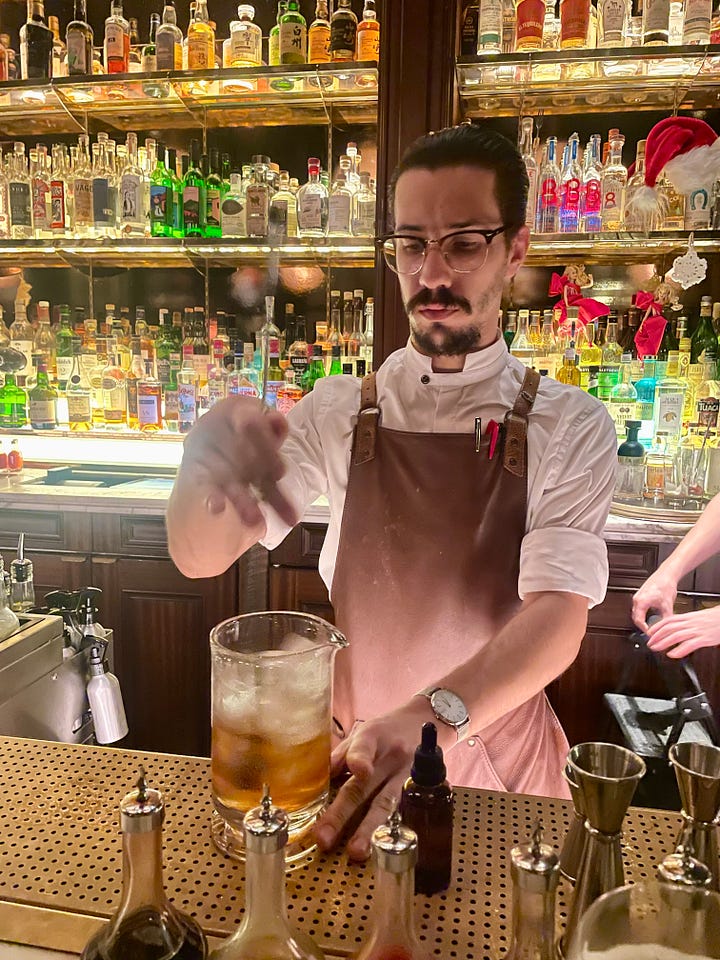
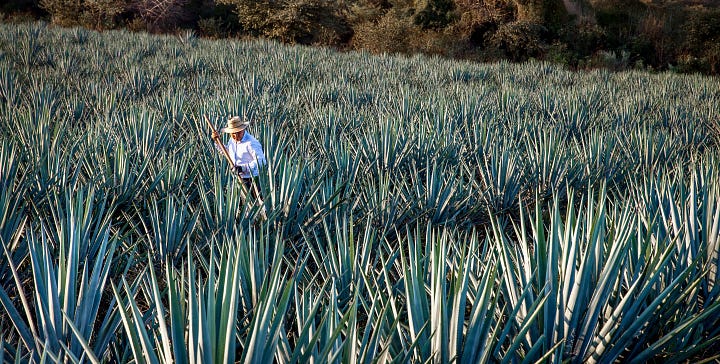
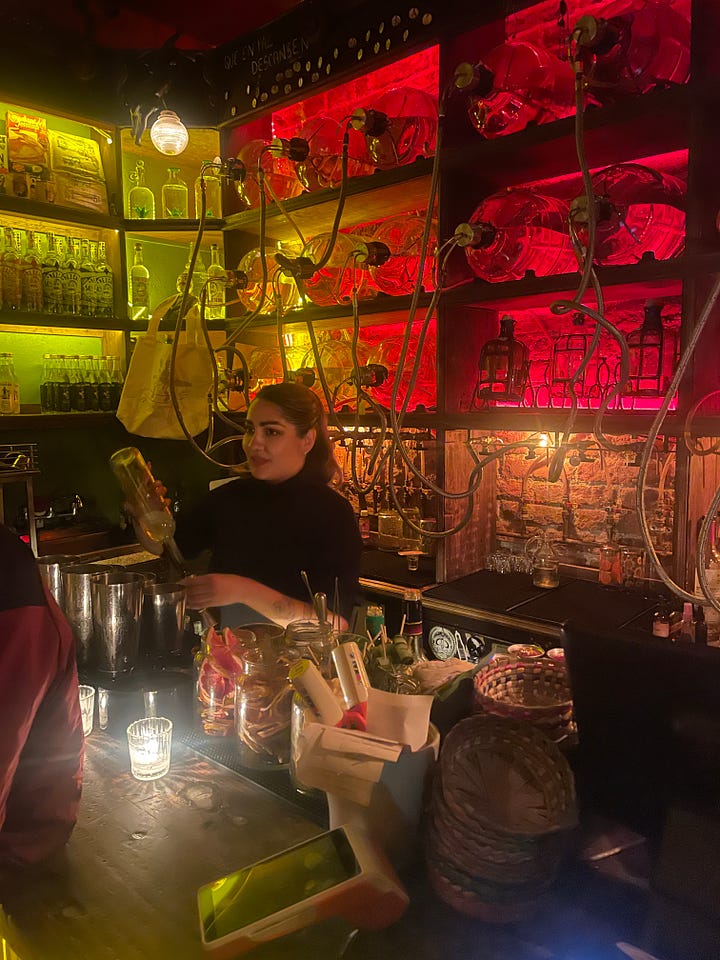
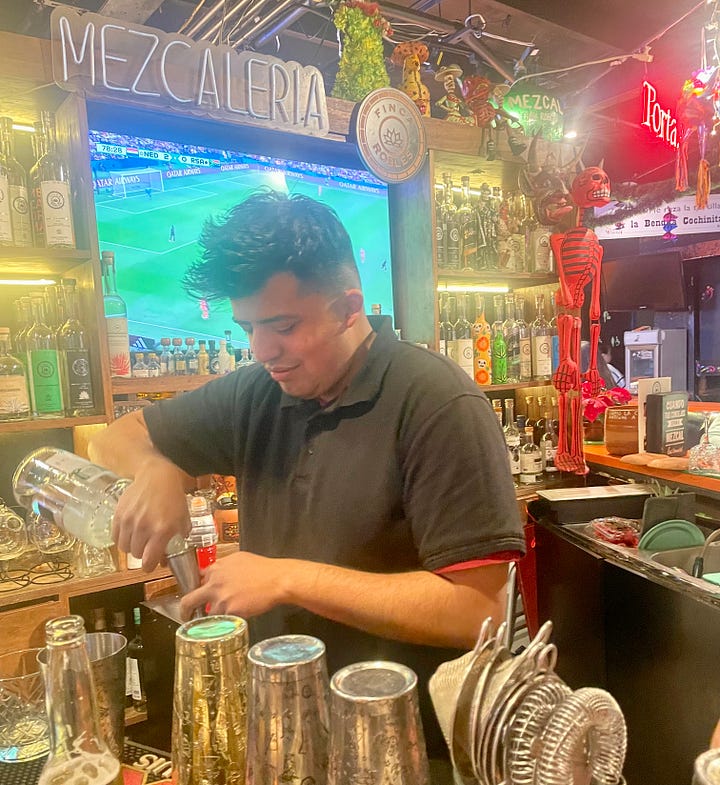
Tequila, it must be said, still has a slightly mixed reputation in Britain. “I thought I hated it because I’d had the university experience of [doing shots],” says actress and entrepreneur Cleo Rocos, creator of the Aquariva tequila brand. “Then one day in Mexico I saw this older, elegant lady sipping it. I asked the waiter to bring me what she was drinking, and it was amazing.” Much later, Rocos spent 11 months in Mexico with a master blender creating Aquariva from highland tequilas.
“Tequila makes you feel happy!” she says. “Like drinking on your first day of holiday.” How very true that is – and I say this not simply because I am now drinking it on holiday in Mexico. Over the past few years tequila has enjoyed soaring sales in America, Britain and elsewhere. In the US, it is now the second-biggest spirit, after vodka, and margaritas make up almost 20 per cent of all cocktail sales. Drinks giant Diageo bought actor George Clooney’s Casamigos brand in 2017 for a cool $1 billion; in 2022, it sold 18 million litres in the US, while its sales in the UK doubled in the year to last August.
“You can pretty much walk into any good bar [in Britain] now and there will be a good agave drink on the menu,” says Dawn Davies, Head Buyer at London’s Whisky Exchange. “Even ten years ago, you wouldn’t have seen that.” British tequila and mezcal sales grew 15 per cent in 2023-24, albeit from a low base.
Tequila is an easy drink to like for mixologists. It has flavour but is still neutral enough to be mixable. It is a trend which, more than most spirits, has been spread by bartenders. “A margarita is always a joyous thing,” says Henrietta Lovell, a Mexico City-based British entrepreneur. “It has no social connotations like G&Ts [gin and tonics] - it’s socially neutral."
“A lot of the demand is driven by women,” adds Davies. “It’s very gender neutral, like gin.” She also points to Britain’s love of Americana and US celebrities like Clooney as a factor in tequila’s popularity. She says the Covid-19 pandemic made people more adventurous, too: “People aren’t afraid to try new things, like tequila negronis.” And to judge by the juddering halt of the gin boom, many Britons also now just seem to be getting bored of gin.
The appeal of agave drinks is deepened by mezcal, tequila’s more artisanal cousin. It often has a stronger, smoky flavour, as well as a bewildering range of nuances – more akin to single malt whisky. And it inspires genuine fascination and enthusiasm in all the bar staff, British and Mexican, that I spoke to for this piece. “I almost think salted dark chocolate by the beach – that’s where my brain takes me,” the barman at Hacha Brixton remarked of one Tobalá mezcal that he poured me.
In fact, mezcal is simply the catch-all terms for all spirits made from agave, or maguey as it is known in Mexico. It can come from a dozen different agaves; tequila, however, can be made only from blue agave, and only in five states, though 90 per cent is from the western state of Jalisco. Blue agave is the easiest species to cultivate and takes five to eight years to reach maturity; the plant dies when it is harvested. This is why producers have struggled to keep up with soaring US demand: they can’t simply up production next year. Decent tequila is always 100 per cent agave and is labelled as such; inferior brands, use a proportion of cane sugar and flavourings.
Production of mezcal is much smaller; while it can be made in nine states, over 90 per cent comes from the southern state of Oaxaca. The production process is similar for both tequila and mezcal. First the agave are chopped back to their heart, or piña: these are big plants and a piña can weigh 200kg. Considering that the rule of thumb is that 8-10 kg of agave piña make one litre of mezcal, and an average-sized plantation might have 10,000 plants, that’s a lot of liquor.
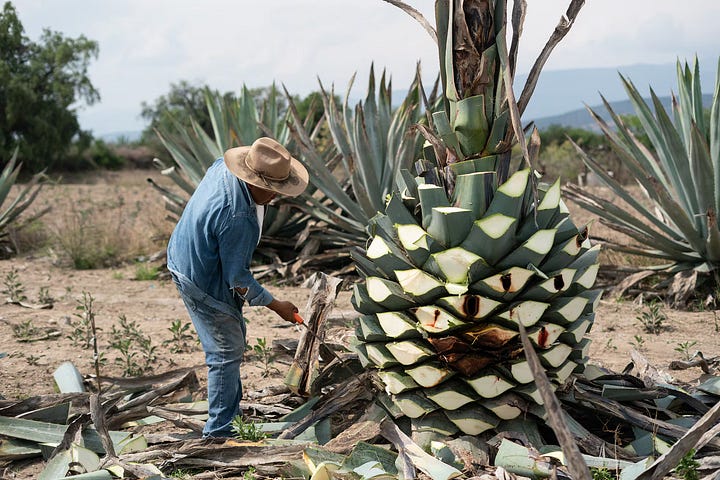
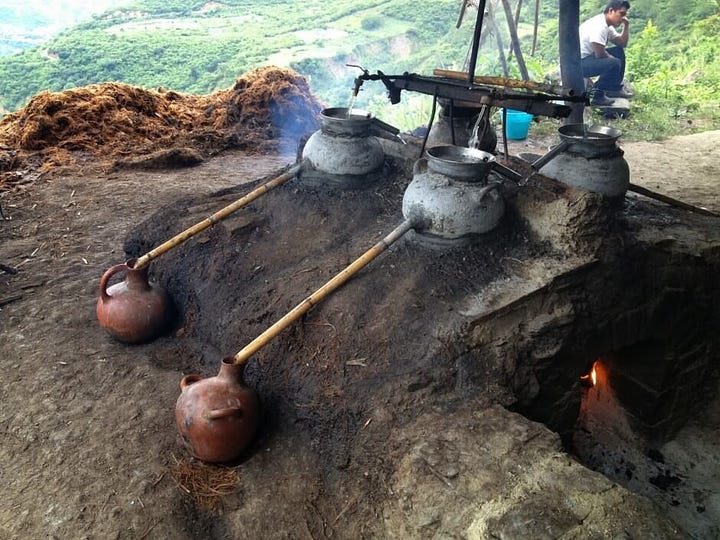
The piñas are steamed roasted (for tequila) or roasted in a pit sealed with earth (for mezcal – hence the smokiness.) The agave is then crushed and shredded, and fermented with water. Finally it’s distilled. That produces blanco (clear) tequila and mezcal. Both can be aged in oak for varying amounts of time to give lightly coloured reposado or older añejo styles, though they start to lose their agave flavour over time.
But mezcal’s other key difference is the agave used: not blue agave but around a dozen other species. Most Oaxaca mezcal is made from Espadín, easy to grow and ready to harvest in six to eight years. Yet astonishingly, many agaves used in artisanal mezcals are wild. The mezcaleros carefully monitor the plants, waiting for them to flower. Some blossom just once in their lifetimes, then die; others bloom several times a year. Either way, the plant’s sugars go to the flowers and seeds, high up above the plant on a single stalk, the quiote. Mescaleros cut off the flower to direct all of the sugars into the piña. Then they harvest the dying agave, planting a seed for every plant they take.
These extraordinary species grow more slowly than the commercial varieties: Tobalá, for example, takes 12-15 years to reach maturity. Tobasiche needs 15 years before harvest, bringing smoky, intense flavours to the mezcal. The rarer Jabalí takes 12-14 years to mature, and demands triple distillation: it’s complex, earthy and herbal. Even rarer still is the Lyobaá agave, a natural mutation of the Coyote species.
It’s fascinating to compare them, as well as the further transformations wrought by blending. Last November, Katrina Aziz, co-owner of the MayaJules brand, staged a tasting at Hacha Dalston: we first tasted the three component agaves unblended, then the finished blend. That mezcal, composed of 81 per cent Espadín and the balance Tobalá and Tobasiche, was subtly more than the sum of its parts.
In Mexico, mezcal has until recently been a more niche product than tequila, at least outside Oaxaca. The country’s image-conscious upper-middle class tend to prefer premium tequila brands: top ones such as Casa Dragones and Clase Azul retail here for upwards of £130 a bottle (in the UK they’re nearer £200.) Edoardo Galliazzo, barman at Mezcalería Tierras Secas in Mexico City’s upmarket Condesa neighbourhood, says that their sales to Mexican customers are around 60 per cent tequila. Mezcal still has an image as a less sophisticated rural drink, he says: “some Mexicans don’t really know what mezcal is.”
However Gustavo, the jovial barman at achingly hip Mezcalería La Clandestina, also in Condesa, says he thinks “there’s been a shift towards mezcal in the past five years, away from gin and whisky. Lots of people drink it in cocktails but on its own too.”
Mezcal’s cocktail popularity is certainly evident in lists like that of Mezcalería Fincas Roble, in the Roma Norte neighbourhood. The most basic mix is the mezcalita, substituting mezcal for tequila to get a pleasantly smoky note – though Fincas Roble offers a dozen flavoured mezcalitas, incorporating fruit including guava, mango and tamarind. And that’s before you get to the mezcaloni (with vermouth and Campari), the mezcal mule, mezcal Pimms and others. Other bars such as Condesa’s Tucco add a sharp-fruity tang to their mezcalitas by using Sal de Jamaica (salt and crushed hibiscus flowers) on the rim of the glass.
Yet away from Mexico City’s hip bars, things are not so rosy - for the tequila producers especially. While a decade ago they scrambled to meet soaring demand with major agave planting programmes, there are signs that the boom is in fact now stalling. Late last month London’s Financial Times revealed official Mexican figures showing that the country is sitting on a tequila lake of more than half a billion litres, almost equivalent to its total annual production.
Part of that slowdown is thanks to US president-elect Trump’s threat last November to slap all Mexican (and Canadian) products with a 25 per cent tariff unless America’s neighbours strengthen their border security. He has threatened further tariffs in response to supposed “trade imbalances”. It remains to be seen whether the toddler-in-chief will follow through on these whims. But added to an increasingly aggressive neo-prohibitionist movement in the US – witness last week’s call from the US Surgeon General for alcohol to carry cancer warnings, and looming changes to US dietary guidelines on drinking – Trump’s posturing is sending a chill through the Mexican industry. The US accounts for more than 80 per cent of all tequila sales, valued at almost $20 billion in 2022.
Those rumblings still seem distant from the dark, night-time embrace of Mezcalería Tierras Secas. It’s easy to forget the industry’s challenges for an evening as I savour a Noble Coyote Lyobaá: warm, spicy, sweet, so complex. “Mezcal is fascinating,” says Galliazzo, an Italian who ended up falling in love with agave and staying in Mexico. “It’s so pure.” I think I, too, have fallen under its spell.
Where to drink tequila and mezcal in London
Side Hustle - this uber-cool bar at Covent Garden’s NoMad hotel serves more than 70 tequilas and mezcals in a very classy dark-wood interior, the vast range of bottles illuminated behind the bartenders. My favourite drink here, though, is their Sergeant Pepper cocktail, an amazing fresh blend of jalapeño-infused tequila, cachaça and verdita (coriander, mint, pineapple, agave liquor and jalapeño).
Kol - Marylebone’s Kol is Britain’s only Michelin-starred Mexican restaurant, using British ingredients to recreate Mexican flavours. Their mezcalería is downstairs and offers over 200 agaves in total, of which around half are mezcals. Friendly staff, innovative cocktails and a good explanation of mezcal and tequila in the menu too.
Cafe Pacifico - this Covent Garden joint claims to be the UK’s first Mexican restaurant, going strong since the 1980s. The bar is a pleasingly dark and friendly haunt, stocking over 160 tequilas and mezcals (video below: bartender Logan in action.)
Hacha - the name refers to the hacha (axe) traditionally used to cut agave: there are two good though quite different London bars, in Brixton market and in Dalston. They carry around a couple of dozen tequilas and mezcals at any one time, and offer cocktails including their award-winning Mirror margarita.
The Pink Chihuahua - founded in 2010 by legendary London mixologist, the late Dick Bradsell, this Soho veteran sits above the El Camion Mexican restaurant. They offer around 40 tequilas and mezcals, as well as some specialities rarely found in the UK, such as sotol, a herby, green-tinged liquor made from species of succulents that grow in the Chihuahuan desert. Oh, and margaritas by the jug, if you’re a crowd.
What I’ve been drinking in Mexico City this week
I flew to Mexico City on New Year’s Eve to spend a couple of weeks staying with my mate James, who is living here for a spell. More on our adventures in food and cocktails next week, but this is what I’ve enjoyed drinking so far:
Bohemia pilsner - I suppose there isn’t really a lot of difference between Bohemia clara (pilsner) and equivalent beers like Modelo Especial: they’ve got a little more weight and complexity than the blander Mexican brews such as Sol and Corona. However, given its near-unobtainability in the UK, I’ve developed a minor obsession with Bohemia over the years (it wasn’t that common even in the US when I lived there in the 1980s and 90s) and so I still get a little thrill when I see it in a bar here. Essential lubrication during long days out walking in Mexico City’s dry, high-altitude air.
Mexican wine - Mexico’s wine industry is small (producing about 48 million bottles a year, well under one per cent of France’s output in a country almost four times the size) and very little of it is exported. Around four-fifths of production is in the western state of Baja California, where cool Pacific air moderates the scorching temperatures. They’re mostly blends, some unconventional but surprisingly decent (eg Monte Xanic Chenin Colombard 2022) while other grapes really seem to be odd choices (eg a Nebbiolo from L.A. Cetto, Baja’s biggest producer). But quality is improving, and there is a burgeoning wine culture where there was basically none until fairly recently, even including a handful of Mexico City bars specialising in natural wines. Reader, in that regard I stuck to beer and cocktails.
Micheladas - ok, so I’ve only actually drunk one of these, in the interests of research. A michelada is a kind of Mexican Bloody Mary made with beer rather than vodka - mine (pictured below) incorporated clamato juice, lime juice, chilli and salsa inglesa (Worcestershire sauce, as far as I could understand the waitress’s explanation) with draft lager. Not unpleasant but a little odd - and would have been even odder if I’d ordered the version including oysters and squid (I’m serious.)
Transparency declaration: I visited Side Hustle as a guest of the bar.




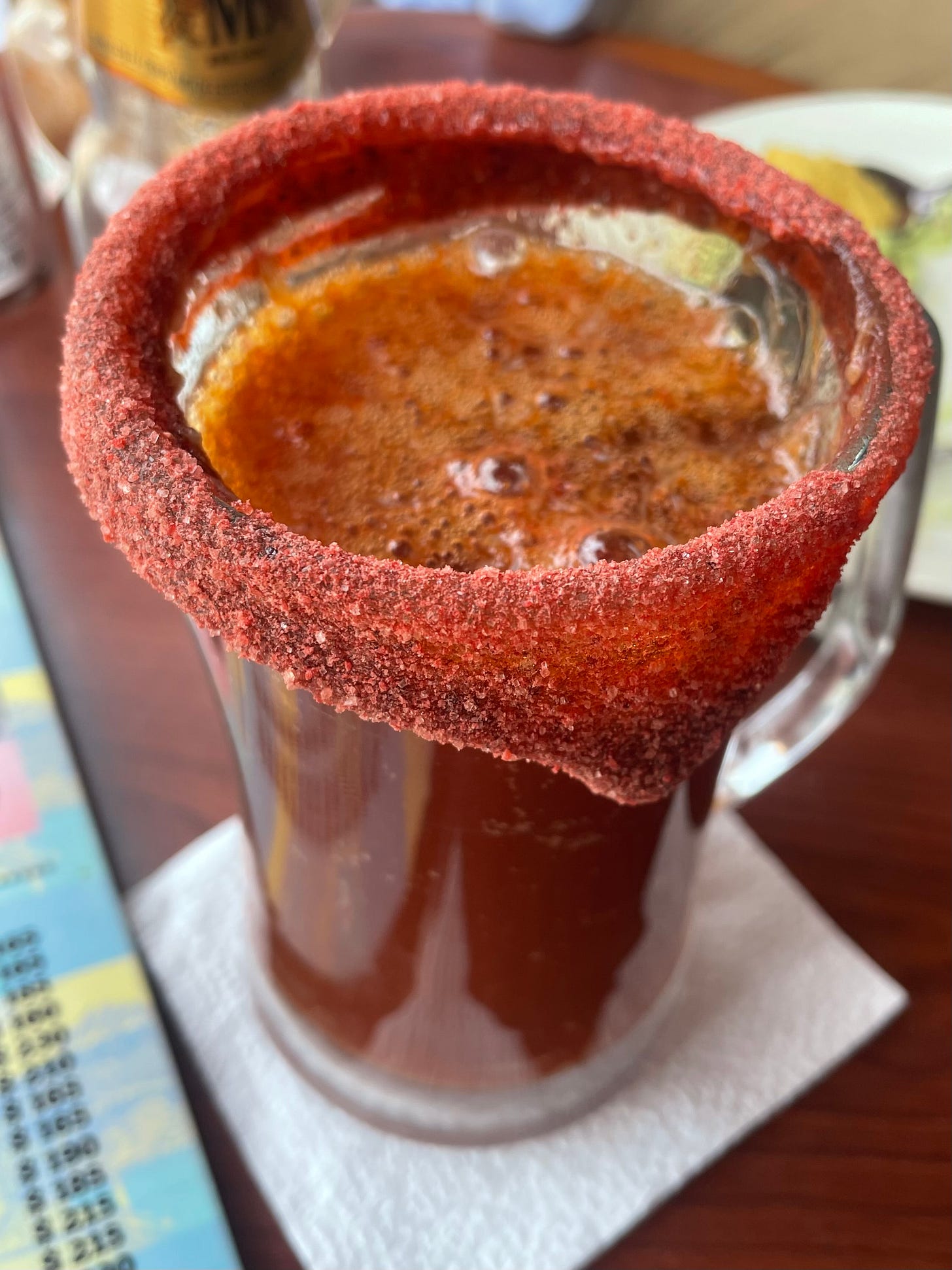
An excellent source of artisanal mezcal here is Sin Gusano , the owner is a true aficionado and I have shelves of mezcal here now as a result
A really informative piece for someone like me, who knows nothing about tequila or mezcal.